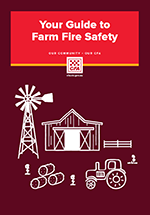Fire management planning for farmers, landowners, plantation managers and bush block owners.
Key advice for farmers
- Fire is an all year round risk management activity.
- Farmers have legislative responsibilities during the Fire Danger Period.
- Effective preparation and response means better recovery and return to business.
- Limit or cease farm machinery activity when it becomes hot, dry and windy, so that if a fire were to start it could be difficult to contain. The Voluntary Grain Harvest Guide (PDF 162.8KB) provides guidance on when these conditions are reached.
- Farmers need to consider the needs of family, staff and contractors on their farm.

Your Guide to Farm Fire Safety (PDF 8.2MB) provides practical tips and suggestions for managing farm fire risk. It covers everything from land and fuel management to equipment maintenance and the protection of livestock and crops from fire. It's presented in simple to read, easy to follow chapters.
For more comprehensive information download a copy of our 'On The Land (PDF 1.8MB)' publication to use as a day-to-day and year round resource on fire safety on farms.
Essential steps before the fire season
Vehicles, equipment and hay
- Double check that spark arrestors on machinery are working and efficient. Make sure chainsaws are free from faults.
- Have water fire extinguishers or knapsack spray pumps (minimum 9 litres) available that can be carried by any person using farm equipment or machinery.
- Have a safety strategy in place for storing and monitoring hay - purchase a moisture metre if necessary.
- Make sure hay is fully cured before baling.
- If you have private firefighting equipment, conduct a 'refresher' session with family and employees to make sure everyone can use it.
- Make sure that there are no gaps between the cladding and the ground or slab of your sheds to prevent embers getting inside.
- Protect hay from rain, leaking roofs and spouts and cover stacks with tarps or hay caps
Fuel loads and stock
- Reduce fuel loads around assets (house blocks, sheds and fences) and create strategic fuel breaks.
- Apply to the relevant authority if you need to remove native vegetation or manage fuel on roadsides.
- Create a heavily grazed area where stock can be moved during a bushfire situation.
- Conduct a stocktake of feed, animals and fencing before the fire season and keep a copy of records off your property.
Permits and laws
- Make a list of legal restrictions (Fire Danger Period and Total Fire Ban) relevant to your property. Display it or keep it handy so everyone on your property can refer to it often and easily.
- Check with your council if local laws are in place for lighting fires, burning off or using incinerators.
- Apply for a Schedule 13 permit from your local council if you intend to burn off weeds, stubble or vegetation during the FDP, or a schedule 14 permit if you intend to use fire for other purposes (e.g. machinery).
Access for firefighters
- Make sure your property name or number is clearly visible so emergency services can identify it easily when approaching the entrance.
- Check access tracks around your property. Consider if access for fire trucks can be improved by clearing vegetation, signposting dead ends or creating turning circles.
- Make sure water supplies around your property are clearly marked in case emergency services need to access them.
Planning
- Have a plan for horses and livestock. A large well-grazed area where they can move freely, with a supply of water, is the safest. Remove all gear from horses and always keep them contained on your property, they are at serious risk on roads where visibility will be poor.
- Have a routine in place for fire risk days (moving stock and limiting or postponing machinery use, switching off electric fences). Make sure everyone on your property is aware of it.
- Fire Danger Ratings are a good way to decide when to leave. They are not a weather forecast – they tell you how dangerous a fire would be if one started. As the ratings increase, so does the risk of a fast moving and uncontrollable fire.
- If you plan to stay and defend a building during a bushfire, take steps to establish a water supply of at least 10,000 litres (independent of the mains supply)
Recovery
- Have contact details for your local council as a first port of call for recovery assistance after a fire.
Case Study
Page last updated: Friday, 11 August 2023 12:41:57 PM